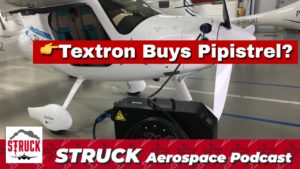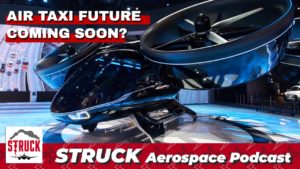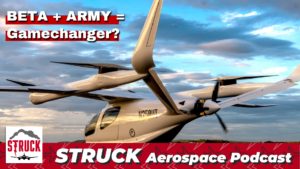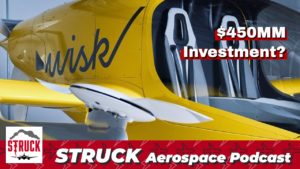In this episode we discuss the Airbus Vahana EVTOL, Gogo challenging SmartSky’s patents, hydrogen tech, Airbus ZeroE, and more.
Learn more about Weather Guard StrikeTape segmented lightning diverter strips. Follow the show on YouTube, Twitter, Linkedin and visit us on the web. Have a question we can answer on the show? Email us!
Podcast: Play in new window | Download
Full Transcript: EP28 – GoGo Challenges SmarkSky Patents; What Did we Learn From the Airbus Vahana EVTOL? Plus Airbus ZeroE & Hydrogen Tech
Welcome back to the Struck podcast. On today’s episode, we’ve got a wide range of topics. Number one, we’re going to chat about smart sky prevailing in a. A patent dispute with Gogo. We’re going to talk a little bit about Airbus and potential unsafe condition. They got a warning from both the, EASA and FAA this past week.
And we’re going to chat a little bit more about Boeing, specifically this week, suspending work at their futuristic next innovation unit. So that unit covers drones, futuristic aircraft, potentially EVT, a Wells air taxi market, stuff like that. We’re going to chat a bunch about hydrogen today in our engineering segment.
So some potential planes being converted to it, and as well as a Airbus concept of zero E. So we’ll chat about those. And the lastly in our electric tech segment, we’re going to talk about Airbus a little bit about Tesla battery day and some of the potential, electric changes upcoming in the future.
So Alan let’s get started. Tell us about this patent dispute, between smart sky and Gogo. So obviously there’s lots of, intellectual property that you know, is, pretty easy, to dispute. I’ve heard that up to 40% of patent, Patent claims are thrown out when they finally actually get disputed in court.
but what is this smart sky company? What does this mean to the industry here?
Allen Hall: [00:01:49] Smart sky and Gogo are in the air to ground ATG. They call it, data, transmission networks. essentially cell towers are located across the country. And as you. Fly above them. It works like a cell phone. Does where you hand off between different cell towers is how it works.
the, real interesting thing about all these systems is that you’re moving at such high speeds and at altitude that the logic to switch between a tower to tower and where to be looking at, to know where the next one is. Is really key to that function of the system, much like the way your, mobile phone works.
and Gogo has been doing that forever and they’ve got thousands of installations on all kinds of business aircraft, and they’ve been the leader in that market for a long time. So smart sky. it has a patent out which sort of overlaps and they’re going to smart sky is saying that they have some IP, they have a patent and Gogo feels like it infringes on things they’re already doing.
And smart sky says Gogo is infringing on their intellectual property. And the patent office, basically stepped out of it. And so when you apply for a patent, the, all the patents are go through like a, pre-publication thing. So the there’s a, process of which the patent office published the application.
And then there’s a list of claims there, and the world could see it. And if I’m, if I have a similar idea or I already have the idea and I’ve put it into practice, I can tell the patent office like, Hey, I, whatever. Company B is doing is, not patent. And here are the 20 reasons why I’m already making and it’s already for sale.
it’s obvious. those prior those knowledgeable in the art would have intuitively come to this conclusion, those kind of arguments that were made there. but I don’t know. A lot of times the patent office like Dan, you were saying the patent office will not want to get involved in those disputes because they are not a court system.
and the patent offices can get in some cases in a pinch there. And so what they tend to do sometimes is Hey, there’s too much of a squabble, let the course decided, and I let them hammer it out, which I’m not sure is a great solution for anybody. But that’s what it seems like has happened here was that the patent office said, Hey boys, you guys fight it out somewhere else we’re out because we think we have just vacation initiatives, patent.
If there was some sort of infringement, you guys have to fight it out, which should I will do because they will clearly do. Now both sides are saying that, go, with saying that they don’t need a smart sky stuff. Smart sky saying Gogo is infringed on their patent. Go saying that three don’t. so maybe it is headed to the courts, because the, real loser would be in the theories.
Smart sky has nothing to lose here because they’re not really in service. They’re in the startup phase in some level. Okay. Go is the big player and has all the money, right? it’d be like a, new, it’s not like the white Knight now, but it would be like when Tesla, was a tiny company suing general motors, a lot of lawyers and a lot of time, and probably not even an equitable outcome, that’s where this, lawsuit is, but it is fascinating that there’s so much competitive playground there.
And I think because Gogo has been Successful in that air to ground market, that everybody is nibbling at their heels because it’s a profitable marketplace to be in. And it’s a system that Gogo has developed over the years, from, I believe it was air cell, and then they’ve developed over the time, but essentially, Google has been there for a while, so they, I think they have, something to say about a newcomer, which is what’s going on.
So it’s just turf, horse a little bit, but it’s interesting to see it play out now. in the middle of a pants, hammock that’s the weird thing.
Dan Blewett: [00:05:58] Yeah, that makes sense. So let’s talk about this. A there’s a warning. So the Airbus, a three 20 Neo family of aircraft, they got a warning from both the FAA and EASA, and they also basically said that there’s been a bunch of instances where engine perturbation was noted when fuel was mixed with cath on FP 1.5 biocide.
So Allen. Can you interpret that for us here? What is an engine for innovation and what is, what is the substance that we’re mixing fuel with?
Allen Hall: [00:06:31] Okay. So engine perturbations always mean, or almost always mean change and thrust on command to change and thrust. Which are usually on the less thrust case.
so if you’re flying along and all of a sudden your engine throttles back with uncommanded because of a fuel quality issue or whatever, it’s sucking through the fuel system that doesn’t want to burn properly, or is contaminating the system. That’s. Big problem, because it can happen on both engines simultaneously, on an a three 20 or Boeing airplane on the 20th jets or so it is a concerning thing, cause it’s like a common point failure or something’s wrong with the fuel.
And you can forget about flying. And a biocide is a, basically a chemical additive to fuel that helps kill mold and mildew and Growing things. So if you think about, I know it’s hard to think about cause you, don’t really think about this in your car, but anytime you’ve got a fuel system that’s enclosed and you add some water to it and a little bit of contaminants air, which has all kinds of stuff floating around at all the time.
so you can get things growing because moisture enough in the tank to get. Mold mildew and all kinds of funky things crawling in these tanks. So if you ever open up a, a big aircraft tank, there’s stuff in it. And especially if there’s don’t have any additives. so what is done is they basically put in, a fungus killer.
Much like you used to, it’s not the same stuff. like you’re using your bathroom to clean the bathroom or something of that sort when you want to get a fungus and mold. something’s water-related and so there’s an additive place in it. The issue is, that additive, obviously it gets burned and pushed to the engine.
And if that engine is, doesn’t like that additive, then it may come ups the system and not. Perform as well. If it gummed up the injectors to the engine where it’s spraying fuel into the jet engine, that would be a problem. If it’s certain to gum up some of the control system components, that would be a problem.
So they, it sounds like they found that they’ve had some actual incidents, not accidents, but incidents where that they’ve determined that fuel additive is affecting the performance of the engines, which is really, serious.
Dan Blewett: [00:09:02] Yeah, back in February of this year, it says the Titan airways, Airbus three 28, three 21.
The, it looks like an engineer accidentally poured in almost 40 times the amount of the permitted dosage. And, yeah, they said there was one the left end and had some surges and the right engine stalled.
Allen Hall: [00:09:21] wow.
Dan Blewett: [00:09:22] Yeah, not ideal.
Allen Hall: [00:09:25] So that was an engineer,
Dan Blewett: [00:09:27] human error. Less engineer. Okay.
Allen Hall: [00:09:33] yeah, I, saw the little article talking about the amount of time to clean that up.
So basically they were forced to drain all the fuel out of the. Fuel tanks and get in there and clean out that additive to make sure it’s not there anymore. And it was about a couple thousand dollars per airplane, which sounds like it’s not enough money, but draining fuel tanks is never really new fun, because if you’re trying to get all the fuel out, you got these collector cans and you’ve got these drain vowels that you’re pushing open the fuel spot down.
It smells. Awful. and you’re trying to collect all that fuel cause you don’t want Atlanta on the ground, obviously you want to be able to reuse it. So it’s just the whole thing smells. And once you get it that far, how are you going to clean it out? more than likely. Yes. Someone’s going to get in there, pop up on one of the wing.
Tank access panels and crawl up in there and take a flashlight and look around and see what’s going on and make sure I don’t have any other things. Yeah, it makes for a fun day. And the, risk on a lot of aircraft today because you have a nerding systems is a. in this case, hopefully the system is open, the, fuel tanks are pumped full of nitrogen all the time.
So you don’t want to open up a fuel tank. That’s been pumped full of nitrogen cause there’s no breathable air. There’s no oxygen in there. there’s added concern about they’re learning systems and opening up the tank. Let it breathe enough where there’s oxygen in there before you stick your head up in there to go look to see what’s going on.
So there’s, it’s. It’s not the most simplest thing in the world. I know it sounds like, an automotive fuel tank. If you’ve got to drain your fuel tank in your car and your Honda, could you do that tomorrow? Dan, I’m just going to down and do that. It’s not the easiest thing in the world to go do.
And the drain, the fuel system is going to take time and that’s a killer for an airline, absolute killer.
Dan Blewett: [00:11:24] So transitioning here, Boeing has suspended work at its next innovation unit. So this unit. Covers potentially delivery drones, urban air vehicles, supersonic, all like the, again, like the things that are a little outside the box.
So we’ve been talking about and electric aircraft, and we’re going to talk about battery, some of Tesla’s battery tech and just the, direction, obviously with hydrogen power industry has got a lot of futuristic things in store for it. But what, what does this mean that Boeing’s pulling out essentially this whole.
This whole future tech race,
Allen Hall: [00:12:02] it means that they’re trying to. So hold on a cash and stop any cash burn on future projects that they don’t really need right now. That’s what it means. Cause that groups is in st. Louis, which is the old McDonnell aircraft group. And so that’s a yes, an older facility that was mostly making military fighter aircraft for the longest time they haven’t made any.
Production airplane in forever. They used to make, they were around when the Apollo project a miracle, I think mercury too. So do you want spacecraft stuff with NASA long ago too? the, so it’s always been a techie place, for when Boeing merged with them. Years ago with McDonald Douglas years ago.
And with the advent, they got seven 37 problems. They have seven, eight, seven problems. Now they got triple seven con Exxon hold. It just got to stop the cash burn and little tiny airplanes right now are not the big selling point for sure. They figured they can ramp it up pretty fast because it looks like they’re trying to keep the engineers, which is.
Fantastic. Because if they do decide to ramp it back up again, they can put the band back together and start making an airplane. It’s hard when you let those people go to try to regroup and get that system back up and running again. I think that’s the be the hardest part. So it isn’t like the. They’ve temporarily disbanded the group, but it doesn’t mean that they’re permanently disbanded.
So I think there’s hope for the future.
Dan Blewett: [00:13:34] All right. So in our engineering segment for today, we’re going to chat a bunch about hydrogen. First a topic of conversation here is a, it looks like a bunch of jets are well, not necessarily all jets, but, so university universal hydrogen is about to, they’re working on a plan to re engine Dashay and ATR 42 airliners.
With fuel cell electric propulsion and or fillable hydrogen modules. So why these two jets?
Allen Hall: [00:14:08] they’re not, just terror props.
Dan Blewett: [00:14:10] Yep. Misspoke. Yup.
Allen Hall: [00:14:11] Yup. So they’re high wing turbo props. And if you’ve, flown short distances, Yeah. In anywhere Europe in the United States, you’ve probably been on one of those two aircraft.
the ATRs made in France and the dash eight was made in Canada. but they’re just very reliable low at this point, low cost aircraft to acquire, to make the mod to them. and they’re also really defendable aircraft too. So they have a lot of service history and, dependable. Flight hours. So it’s a stable platform to change one variable, which is the, fuel system.
And to try to drive it to a hydrogen fuel system. I’ve seen some of the sketches on it. And Dan, you can give me some advice here. So they’re taking these hydrogen, like fuel tank. Cargo pods. I’ll call them. Yeah. And loading them into the sort of the back end, whether we normally put cargo in the backend of the ATR 42.
Those things would be really cold. Like liquid hydrogen is really, cold. So what does that look like? May, is it like the smoky container box sets, Coke getting shoved in the back?
Dan Blewett: [00:15:27] I think it’s going to be like that pizza, like that, black nylon thing that they deliver pizzas in, it’ll be like that.
Just bigger, So a guy comes, he’s got the hydrogen pods in one hand and he goes, Hey, I got your hydrogen ready to go. No, but you’re right. That, probably takes some, that seems like that’s gotta be a major, part of the, of this restaurant fit. I’ve just read it
Allen Hall: [00:15:53] and temperature, Venting and temp. Cause there’s going to be some venting going on and they gotta be. I guess venting that stuff over, the edges that as the hydrogen
Dan Blewett: [00:16:04] keep a, like a system to keep everything just in place. these pods can just rattle around. There’s gotta be a pretty big page and there’s just, you talk all the time about adding weight.
And how that just complicates the design of especially new aircraft. But, but yeah, this seems like there’s just like a lot, that’s got to go into to securing this, getting the fuel delivery system working. And like you said, keeping the refrigeration and venting and all that stuff. And check. It just seems like a really complicated switch over.
Allen Hall: [00:16:32] Yeah. Because you’re taking the fuel is stored right now. And the conventional version of these aircraft, the fuel is stored in the wings, or in, the center section two. So there’s, you’re basically fly with it, wings empty and they are made to do that, I think. But there, I think on the loads.
Okay. So I’d be curious to know if that’s smart on a Lowe’s case because there’s, always some intrinsic weight there normally. so now you’re gonna fly with them empty, not sure how that’s going to go. And then, the, the, and out of a fuel systems, they’re not, I can’t think of a fuel system that’s designed today for any aircraft.
That’s sorta removable.
Dan Blewett: [00:17:15] Which is an interesting concept. Yeah. it’s an interesting concept, but it does seem clunky, not clunky, but a lot of moving parts, a lot of,
Allen Hall: [00:17:25] So you’re not making the fuel tank system integrates with the aircraft, which is interesting. Is it because you, don’t have the hydrogen source on site to fill it, or the filling process is risky.
There’s something about that. I don’t understand because normally. If you’re wanting to change a fuel system, like, we got into some green aviation fuels, we don’t really change it in a way, the way the fuel system works. Obviously if you go into hydrogen, you need to, because there’s a temperature and it’s a gap and yeah, there’s a lot of
Dan Blewett: [00:17:53] things about
Allen Hall: [00:17:54] that.
certification. So I wonder what a certification towards is going to say about it and what other. Things are going to impose on them as they go through this process, which is the big unknown, right? If you get into this process and you’ve got a year end and then the FAA or somebody transport candidate JASA says, Hey, we’re going to create a new rule.
We didn’t envision put these hydrogen models in the cargo area, which they haven’t, you haven’t envisioned putting these cargo modules full of hydrogen in the back of this aircraft. We’re going to write some special rules for you. You can just see costs explode
Dan Blewett: [00:18:28] whenever you go.
Allen Hall: [00:18:30] And you’re going to get bought the checkbook, call the investors and ask for some more money because that’s what will happen.
And that’s why these, if you’re going away from some sort of conventional system, that’s why that’s what the huge risk is, that you don’t really know what the certification towards you’re going to ask you to do. And, there’s really no precedent.
Dan Blewett: [00:18:49] yeah. And, the other thing, you mentioned why can’t they just fill the plane directly, like with hydrogen.
And as we’re talking about weight, you talk about the surface area of the metal of these containers, whatever they are, if you have eight, eight individual pods, the surface area to enclose, each of those pods is going to make it way more metal surface area than if you just had one big, one big canister holding it all.
Like you see it like those, those gas, storage places where it’s just a huge tank, which saves, much less metal surface area. So there’s going to be way more weight. So you wonder why. Why the module modular design where they’re, so it appears like they’re small. Like they might need a load eight of these on there.
Whereas if there’s half the number of them, they’re going to save some weight there, but maybe I’m wrong. I don’t know.
Allen Hall: [00:19:37] It looks like it’s a forklift thing, but they have access to a forklift, which is the maximum lift capability is X. And so they want to keep it below X. That’s what it looks like, but you’re right.
It does. It does add a what. Aerospace engineers would qualify as dead weight. It’s not providing any function besides the whole, make it compatible to lift around and move around on a truck or on a forklift, for airplanes concerned. It doesn’t add any benefit. So you’re right.
Dan Blewett: [00:20:06] Let’s chat more about, hydrogen.
So Airbus, they have a new concept aircraft and this is in their zero E line. And this is a, blank, a blended wing.
Allen Hall: [00:20:19] Aircraft
Dan Blewett: [00:20:19] concept, which it basically looks like a boomerang also like a, I think it’s called a, is it a sailfish? It’s have you seen that one? I think it’s well, the whale family, but it looks, maybe it’s a sunfish, but it’s this huge sort of whale like creature and it just, they have a similar shape.
I can’t think of the exact one. I should’ve done my animal kingdom research before the show, but manta Ray. I’ll have to look this, creature up later. But, so w when we’re talking about blended wings, why do account, why the aircraft not really use that design today? Like, why would it work in this design?
And if it would work in this design, why haven’t we been seeing them in the past?
Allen Hall: [00:21:04] and it has to do with the evolution of aircraft and how they built their crafts. And the simplest way to build aircraft is to make them a bunch of cylinders and cause you’re pressurizing them also. So the easiest thing to pressurize as a cylinder.
it makes gasoline does all the time. So it just, it equalizes the forces and does all the things you want it to do. So the sh the shape doesn’t really change from some sort of roundish thing. and yeah, it’s just efficient use of space, right? So you can make a tube, you can put luggage underneath, you can put baggage up top.
You’ve got life rests in the ceiling. You’ve yeah. You can niche it out where everything needs to go. When you go to a, blended wing concept. It changes the way everything goes together. So it’s like starting with a clean sheet again. And the reason you do that is that you got to put a hydrogen tank or tanks somewhere to store the fuel and it’s going to have to be insulated and it’s going to have all the stuff.
instead of. Creating, basically some of the concepts that’s been tossed around for awhile. I was just basically putting a, basically a hydrogen cylinder storage tank in the back or in the back of an existing cylinder, like aircraft. So like taking an Airbus three 20 and just making it longer, where are you going to put the cylinder back there?
And the wings would be essentially empty of fuel. what do you do with that empty space? Who knows? But, so I think it’s the trade off, right? So you, could take an existing Airbus, three 20 design. Extend the back of it puts a hydrogen cylinder back, get in there and leave the wing tanks, empty.
But where do you put luggage? I guess under the underneath, or you can just like clean sheet the whole thing and say, all right. If I was going to make the most efficient aircraft I could, the blended wing is. that shape. Can I then full of hydrogen somehow? Probably because we have room real estate to do it.
The issue with the blended wing is that really two things? three, one, you haven’t really have any history of flying such a aircraft before. two, there really are no windows. So as a passenger, you’re sitting in this enclosed space,
Dan Blewett: [00:23:15] Yeah. I didn’t think of that. You’re right. And you’re just going to be way more area.
Where you’re stuck. Yeah,
Allen Hall: [00:23:20] yeah,
It wouldn’t be any windows, so to speak. So people don’t like being locked up and tubes with windows and I can’t, locked up in a cylinder with no windows is going to be another level of terror.
Dan Blewett: [00:23:33] you know where this is going on. Do you remember the movie, the fifth element where they’re going on this flight?
Bruce Willison, I can’t remember. Lilu they’re going to philosophy and paint. Flawsome paradise. he’s, on the place. They’re going, he’s on the PA. Okay. But the, anyway, my point is they, all go on this, big spaceship and they all go in their little tubes and then they like hit a little airlock and they all just pass out and then they just arrive when they get there.
which to me sounds great. if you just fell asleep and or zonked out asleep and you just woke up at your destination, it’s like time travel essentially. So maybe they would have some sort of component like that. if, it was really viable and they’re like, Hey, Look, this is, the way this is going to be.
We don’t really have, window capabilities, but it’s going to get you where you need to go, blah, blah, blah. It’s going to be like a little, a sleeper pod kind of experience that might be cool. I might, I might do that. I don’t mind confined cozy spaces. You have a movie and whatever.
I don’t know. We’ll see, but those are legitimate design limitations, so
Allen Hall: [00:24:38] yeah. Yeah, they are. And the other thing about the whole blended wing design is it changes all the systems. So we’ve evolved for a little over a hundred years and designing aircraft systems a certain way with a certain sort of knowledge base behind it.
And now we’re essentially going to take that out and dump it all and start all over again, which is where errors occur in calculations or miscalculations are made. And then you have problems with airplanes. So there’s a huge risk. and that’s why it really hasn’t been done by anybody on any level. the blender wing.
The only thing that I would even call remotely blended wing is like the BTU and the, then the processors to the B two bomber. But after that, there really aren’t any, it wasn’t the most successful aircraft in the world. I think we made 50 of those and there’s been a couple of crashes, so we’re probably at 45 or so.
so the, blended wing design, even though they aren’t an emesis love it, does have a straw backs. And I wonder if, part, this is that Hedvig thing that Boeing and Airbus like to deal with one another once in a while, which is say, Hey, we’re going down this pathway then last second. Oh no, that’s a bad design.
We were already working on another design anyway. And. Get your competitor to chase ya. And, has that feel to it for right now because there’s so much money and work to be poured into this project. unbelievable sums of money. It will be billions and billions of dollars to, make this thing happen.
It really will.
All
Dan Blewett: [00:26:19] So in our final segments, they were gonna chat a little bit again about some EVT, a Well’s first one on the docket today is the Airbus Vahana. So obviously with Boeing exiting, this sort of market this game, airbases had this project going on since, 2015, so it’s a four year old project.
And as of November of 19, the Vahana had taken 138 flights, 13, 13 and change flight time hours. they’ve flown about almost 500 nautical miles with their farthest flight being 27 nautical miles. A really unique aircraft. but I think the big talking point here is, number one, it’s I think it’s always a big deal.
One that one of the big aircraft manufacturers is doing something in this space, This isn’t like any of these, Lilium or, John Deere mobility or Joby these, those are all much, smaller companies than obviously the Airbus is a big player. Yeah. so it’s a big dealings. I’m Airbus or Boeing, or doing something in one of these spaces, but, it’s a, unique, or this one does have the, what do you call them?
Allen? When they, the, props will turn props. Yeah. Tilting props. So this has tilting props. it’s basically like a one Cedar and. Very cool, sleek design, but I think our talking point for today, more than what this one can do, which this doesn’t seem like it’s really destined for anything specifically, but like where’s this, where’s this going, Airbus tests, the waters and they push the limits of what aircraft can do.
And then you have companies like Tesla as well. announcing some really cool battery tech where that might change the way. All of these EBTL Wells are, or the direction that they’re all headed because Hey, new battery tech makes so many more things now viable. we can do things with less weight, lower cost, higher capacity, higher power.
so what’s your take on some of this of air buses doing some of the stuff that Tesla’s been doing? I feel like there’s been a lot of. A lot of stuff going on in the space,
Allen Hall: [00:28:29] right. There’s, been a lot of activity in a variety of different areas. The aircraft designs and the Airbus design is at this point commonplace.
I would say if you see a lot of similar aircraft shape and complexity, And they all starting to look the same. Yeah. which shock of all shocks. the engineers finally figured out what an optimum design is and they’re all coming up to the same country, illusion, no shock there.
but. The, fact that Airbus is, putting their time. Oh, when the water, so to speak, to test it out and see what the temperature is of, that marketplace and to see how they can, function in that marketplace, because it’s a totally different thing to go after. when you’re making a F eight, 300, three 43 20, those are big, massive things with huge amounts of infrastructure.
Big facilities, a lot of support engines, fuel systems, hydraulics. It’s just enormous complexity to getting all that, to work together as well as they do. And then it to try to then go to something extremely small, lightweight, and still relatively complex with a lot of computer integration and system integration into it.
This is a different animal and I’m not sure it’d be like it would, it’s the Tesla GM thing right now where. you really got to think differently about how you do these designs. If you’re going to make any money on it and you can lose money at it pretty easily. I think that’s where people are.
Some of these companies are getting really realizing like, Oh yeah, this looks cool, but it’s really difficult to build. And I can’t afford to make this thing where we’re going to make it. We can either redesign the way we build and think about aircraft. And they don’t have the cashflow to do what Tesla is doing.
So the, Tesla, changes are dramatic on an engineering level. Maybe not on a, cool car level, cause they haven’t really introduced any real new car concepts, so to speak. So they’ll working on how you make the car and how you cut a lot of the costs out. And that sort of philosophies, what must cause the first principles let’s get down to first principles.
I need to get from a, to B with this product. How do I do that in the most efficient way? Not how do I do it today or how the rest of the world does it today? Because that’s evolved over time. And those tend to be went a to B, to C, to B, to D to get to the finals, final configuration of the product.
they want to go from a, to B in the most efficient way, and that takes. And enormous amount of cash to do it on an airplane, small airplane in which the quantity will be limited. I’m not sure. Sure. You can do that. So now, I think happening for a lot of these companies is they’re trying to figure out how to make them inexpensive, not cheap, right?
There’s different. I can make them cut down the manufacturing costs, but keep the quality up and the consistency of yeah, there. There’s where the driver is. Anybody can make an airplane. Fly today for the most part, what the killer is, keeping the cost down so people can afford to buy it. And you’ve got a profit margin.
That’s where the engineers are really going to take hold, which is also why I think some of these companies are ending up in Silicon Valley or in very techie areas instead of Wichita, Kansas. Not that Wichita, Kansas is great. I love which like Kansas, quite honestly, it’s a great place to live, but, when it gets so computer.
Technology driven. There’s a whole pile of engineers out in Silicon Valley. That’s all we think about and that’s what they’ve experienced. So you can actually tap into sort of that Tesla experience. You see those Tesla people getting scattered, Google people. No, it’s just that I think things a little bit differently.
Yeah. I haven’t been in that industry and have a certain mindset that just taking a fresh sheet of paper now, how is what work we’re going to find out? But I think that’s the philosophy, even with Lilium and some of the others that are based in Europe is that they’re trying to get to these tech centers and use really smart people to rethink the way they build airplanes so they can make some money in these projects.












